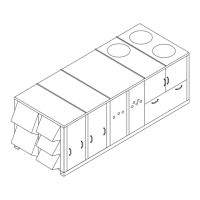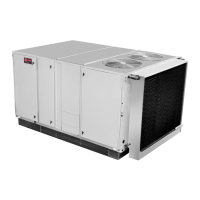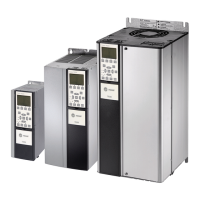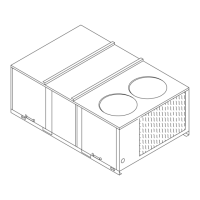36 RT-SVX34C-EN
Installation Electrical
1. Calculate the MCA, MOP and/or RDE values using the above equation as if the unit is operating
in the cooling mode.
2. Calculate the MCA, MOP and/or RDE values as if the unit is operating in the heating mode, as
follows:
Note: When determining loads, the compressors and condenser fan motors do not operate during
the heating cycle.
Units with less than 50 KW Heaters
MCA = 1.25 x (Load 1 + Load 2 + Load 4) + (1.25 x Load 3)
Units with 50 KW or Larger Heaters
MCA = 1.25 x (Load 1 + Load 2 + Load 4) + Load 3
The MCA value stamped on the nameplate is the largest of the two calculated values.
MOP = (2.25 x Load 1) + Load 2 + Load 3 + Load 4 (See Note 1)
The MOP value stamped on the nameplate is the largest of the two calculated values.
RDE = (1.5 x Load 1) + Load 2 + Load 3 + Load 4 (See Note 2)
Note: Select an over current protection device equal to the MOP value. If the calculated MOP value
does not equal a standard size protection device listed in NEC 240-6, select the next lower
over current protection device. If the calculated MOP value is less than the MCA value, select
the lowest over current protection device which is equal to or larger than the MCA, providing
the selected over current device does not exceed 800 amps.
Note: Select a Dual Element Fuse equal to the RDE value. If the calculated RDE value does not
equal a standard dual element fuse size listed in NEC 240-6, select the next higher fuse size.
If the calculated RDE value is greater than the MOP value, select a Dual Element fuse equal
to the calculated MOP (Maximum Over current Protection) value
Disconnect Switch Sizing (DSS)
Calculation A. - YC*, TC*, and TE* Units:
DSS = 1.15 X (LOAD1 + LOAD2 + LOAD4)
For TE* units, use calculations A and B.
Calculation B. - TE* Units:
DSS = 1.15 X (LOAD3 + Supply Fan FLA + Exhaust Fan FLA).
Use the larger value of calculations A or B to size the electrical disconnect switch.
Low Voltage Wiring
An overall layout of the various control options available for a Constant Volume application is
illustrated in Figure 19, p. 39. Figure 20, p. 40 illustrates the various control options for a Variable
Air Volume application. The required number of conductors for each control device are listed in the
illustration.
A typical field connection diagram for the sensors and other options are shown in the following
section "Remote Panels and Sensors". These diagrams are representative of standard applications
and are provided for general reference only. Always refer to the wiring diagram that shipped with
the unit for specific electrical schematic and connection information.
Note: All field wiring must conform to NEC guidelines as well as state and local codes.

